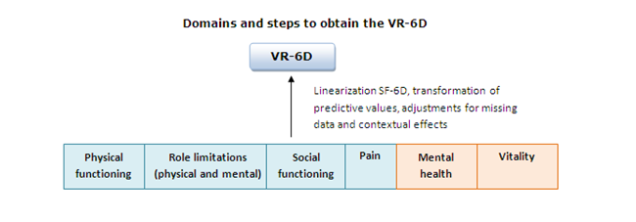About the VR-36©, VR-12© and VR-6D©.
VR-36© and VR-12©
The Veterans RAND 36 Item Health Survey (VR-36©) and the Veterans RAND 12 Item Health Survey (VR-12©) are brief, generic, multi-use, self-administered health surveys comprised of 36 and 12 items respectively. The instruments are primarily used to measure health related quality of life, to estimate disease burden and to evaluate disease-specific impact on general and selected populations. The items on the questionnaire correspond to eight principal health domains including general health perceptions, physical functioning, role limitations due to physical and emotional problems, bodily pain, energy-fatigue , social functioning and mental health (Figure 1).

The VR instruments use five-point ordinal response choices for seven items in the VR-36© and four items in the VR-12©. Response choices that were originally dichotomous (a two-point yes/no choice in the SF-36 version 1.0) are now five-point response choices: “no, none of the time”, “yes, a little of the time”, “yes, some of the time”, “yes, most of the time” and “yes, all of the time”. These answers then contribute to the scales for role limitations due to physical and emotional problems and the physical and mental summary scores (Figure 2 and Figure 3):
1-Physical Component Score (PCS): Provides greater emphasis on questions about general health, physical functioning and role playing and bodily pain.
2-Mental Component Score (MCS): Provides greater emphasis on questions about role-emotional, vitality/mental health and social functioning.
These summary scores allow differentiating between physical and mental health.

Click image to view larger.
VR-6D
The VR-6D© is a utility measure derived from the VR-12© and SF-36 version 1.0 using the Brazier SF-6D as the basis for the mapping between the VR-12© and the VR-6D©. Utility values capture personal preferences for health states on a scale from 0 to 1, where 0 denotes death and 1 optimum health, with negative values for states worse than death. The VR-6D© can be used in evaluations of health care plans and cost-effectiveness analysis to compare the health gains vs. costs that health care interventions can achieve. Figure 4 presents the 6 domains the VR-6D© is composed of and the main steps in its development. The VR-6D© is currently based on UK weights but the VR research team is developing US weights, which should be available in the near future.


